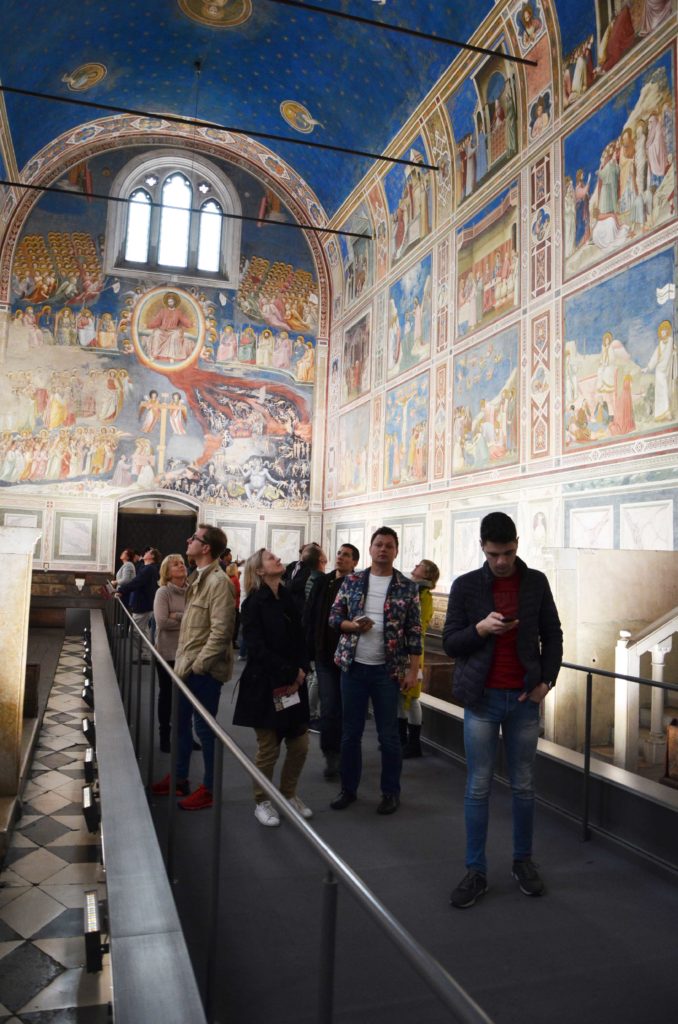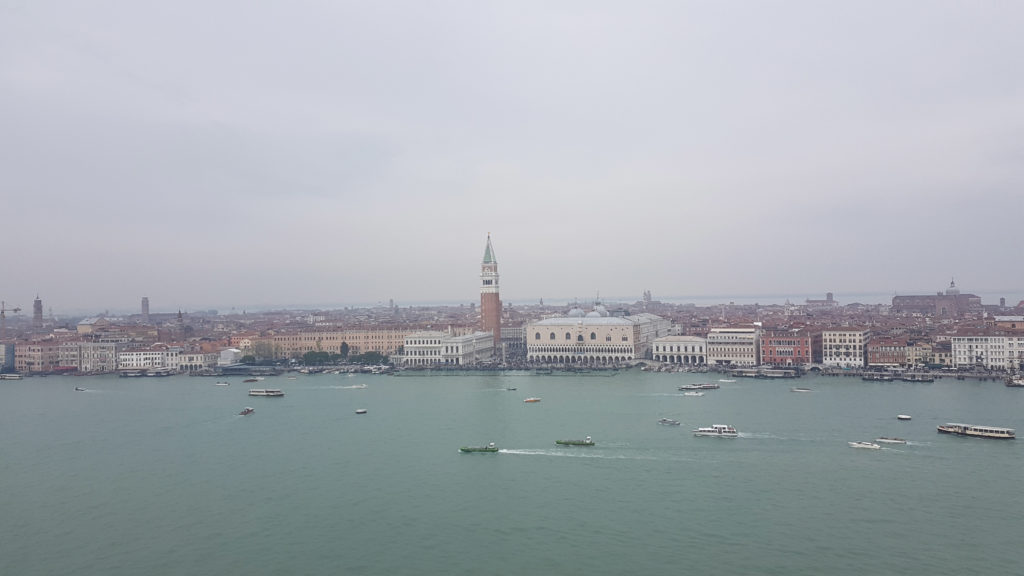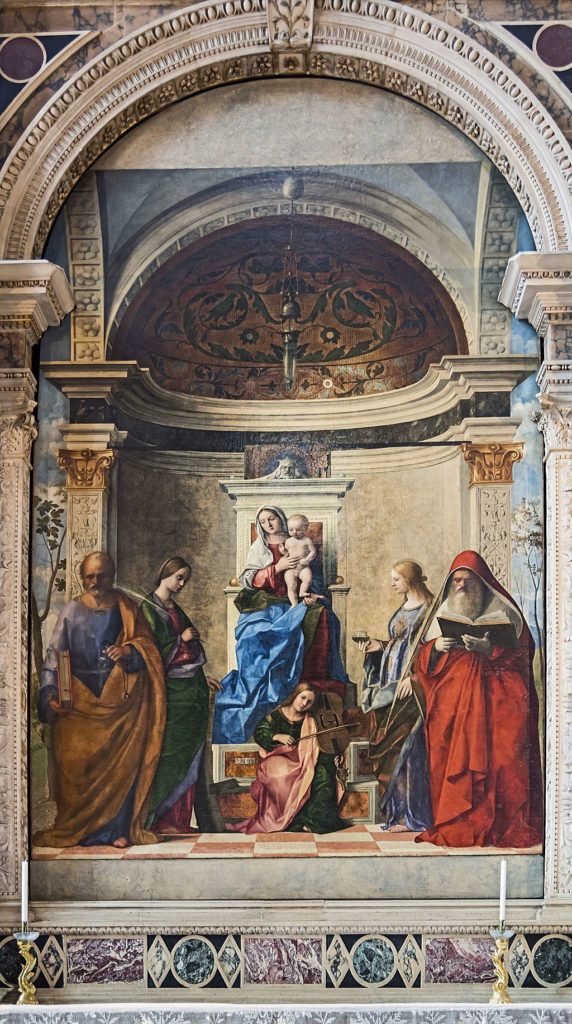Three students from the Department of History of Art reflect on their recent trip to Italy where they explored the architecture of various cities.
Around 30 Birkbeck students – postgraduate and undergraduate – congregated in Venice in April 2019 for the annual week-long study trip, led by the indefatigable and super knowledgeable Dr Sarah Ferrari and Dr Zuleika Murat from Padua (Padova) University. Three of the group, Sue Joshua, Angela Parry, and Steve Cragg, share some of their memories and experiences….
Angela, an MA Museum and Cultures student:
If you think you know a city – think again! These study-tours are not just about ticking off the top ten tourist attractions, but exploring off the beaten track, and taking time to really look at stuff! We arrived on a slightly damp and chilly day, successfully negotiated the Vaporetto and found our hotel in Arsenale – a great location with lots of friendly local restaurants and cafés. Then it was full-on. Taking in the unique beauty of Venice, walking, chatting with everyone and catching up with people from the 2018 Berlin trip (it’s easy to get hooked and keep coming back on these tours!). My favourite off-tour location was the Greenhouse café at Sera dei Giardini in Castello, built in 1894 to create a “tepidarium made of glass and iron” and now a great place to just relax with coffee and a good book. Top Tips; get the Blue Guide is great for extra information, comfortable shoes and an umbrella are essential, rest your eyes with some contrasting art. Sue, Steve and I took an hour out for a welcome blast at the Guggenheim Collection – and then it was back to those amazing frescoes!
Sue, an MA History of Art student:
Speaking of frescoes…. Mid-week we visited Padua, about half an hour from Venice by train but a world away in terms of architecture, open space and general tempo. The city  is renowned for its fourteenth-century fresco cycles, many of them well preserved and easily accessible. Some of these testify to the ability of powerful and wealthy individuals to possess and transform prestigious urban spaces. Enrico Scrovegi was a wealthy merchant from a family with a dubious history of moneylending or usury. On land originally used as a Roman arena, he built a palace with its own private oratory, known as the Scrovegni (or Arena) Chapel. Visitors must sit in an air-conditioned waiting room for 15 minutes to allow their body humidity to cool. Time in the Chapel itself is limited to 15 minutes for a maximum of 25 people. Every surface of the walls and the barrel-vaulted ceiling is painted. There is a sense of being sheltered under a blue sky, pierced by stars, the colour an extraordinarily bright and deep ‘Giotto blue’. Nothing had prepared me for the visual and conceptual world created by Giotto in 1305. The central themes are the life of the Virgin and the life and ministry of Jesus, beginning with the story of Mary’s miraculous birth to her elderly parents Joachim and Anne. The narrative is presented chronologically, starting from the top tier and working around the Chapel and down in a kind of spiral, each scene pointing to what will follow. There are closed buildings and open spaces, contrasts of light and shade, bright and beautiful colours and above all humanity, wit and recognisable emotion in Giotto’s depiction of his characters.
is renowned for its fourteenth-century fresco cycles, many of them well preserved and easily accessible. Some of these testify to the ability of powerful and wealthy individuals to possess and transform prestigious urban spaces. Enrico Scrovegi was a wealthy merchant from a family with a dubious history of moneylending or usury. On land originally used as a Roman arena, he built a palace with its own private oratory, known as the Scrovegni (or Arena) Chapel. Visitors must sit in an air-conditioned waiting room for 15 minutes to allow their body humidity to cool. Time in the Chapel itself is limited to 15 minutes for a maximum of 25 people. Every surface of the walls and the barrel-vaulted ceiling is painted. There is a sense of being sheltered under a blue sky, pierced by stars, the colour an extraordinarily bright and deep ‘Giotto blue’. Nothing had prepared me for the visual and conceptual world created by Giotto in 1305. The central themes are the life of the Virgin and the life and ministry of Jesus, beginning with the story of Mary’s miraculous birth to her elderly parents Joachim and Anne. The narrative is presented chronologically, starting from the top tier and working around the Chapel and down in a kind of spiral, each scene pointing to what will follow. There are closed buildings and open spaces, contrasts of light and shade, bright and beautiful colours and above all humanity, wit and recognisable emotion in Giotto’s depiction of his characters.
Steve, a BA History of Art student:
Back in Venice, I’m concentrating on one work that stays with me from the trip. We gathered in the rain early one morning in an eerily quiet square a stone’s throw from St Mark’s, and in front of the Convent and Church of San Zaccaria. Containing many stunning works, the five-metre high altarpiece (also known as Madonna enthroned with Child and Saints) by Giovanni Bellini from 1505 stands out (and the photograph I took is still my screen-saver).
It is an outdoor view of the Virgin and infant Christ in a rich architectural setting. The main figures are flanked by meditative saints; whose demeanour and posing encourage a similarly thoughtful attitude in the viewer (especially this one suffering a little from too much Valpolicella the previous evening). St Peter on the left earnestly clutches his keys in contemplation, and on the right St Jerome is immersed in an enormous Bible. The inner figures of St Catherine and St Lucy bend attentively towards the Virgin. A single angel plays a stringed instrument at the foot of the Virgin’s pedestal. Spending time in front of this work provides the perfect retreat from tourist-besieged Venice. Although fighting to get a glimpse of the golden mosaics in St Mark’s was worth it too.
Next year’s trip has not been announced yet. But do think of going – travel and accommodation are up to students to arrange, but the study programme itself (after entry fees etc.) is totally free. The trip is made possible by the generous support of the Murray Bequest and was set up in honour of the department’s founder Professor Peter Murray. The Bequest also offers a number of bursaries every year to students who would otherwise be unable to attend. Details on how to apply are circulated to students when information on the trip is released – usually in December or January. You can read blog posts about past trips here.
Further information:



A wonderful time had by all! I really enjoyed the school visit to Berlin last year and found it really helpful for my art history studies later that year. This year I’m enrolled in the MA History of Art but unfortunately could not make it to Venice in April. I am going to visit for the last week of September however and would welcome any further suggestions about places to visit.
Hey.. I am Sandeep sharma thanks, you have made a wonderful post I love and appreciate your words.